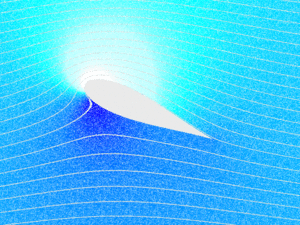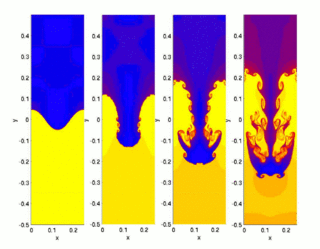Fluid dynamics facts for kids

Fluid dynamics is the study of how fluids, like liquids and gases, move. It's a part of a bigger subject called fluid mechanics. Think about the wind blowing, water flowing in a river, or even the air moving around a flying airplane—that's all fluid dynamics!
This science has two main branches:
- Aerodynamics: The study of how air and other gases move. This is super important for designing airplanes and rockets.
- Hydrodynamics: The study of how water and other liquids move. This helps us understand everything from ocean currents to how water flows through pipes.
Fluid dynamics is used in many amazing ways. It helps engineers calculate the forces on an aircraft, lets meteorologists predict the weather, and even helps doctors understand how blood flows through our bodies.
Contents
The Basic Rules of Flow
Even though fluid flows can look complicated, they follow a few basic rules based on physics. Scientists use these rules, called conservation laws, to understand and predict how fluids will behave.
- Conservation of Mass: This rule says that you can't create or destroy a fluid. Imagine you're watering a garden with a hose. The amount of water that goes into the hose is the same amount that comes out the other end. If you put your thumb over the end, the water sprays out faster, but the amount of water flowing per second is still the same.
- Conservation of Momentum: This is based on Newton's laws of motion. It means that a force is needed to change the speed or direction of a fluid. A fast-moving river has a lot of momentum and can push rocks and logs downstream. To stop or change the river's flow, you would need a very strong force, like a dam.
- Conservation of Energy: This rule states that energy can change from one form to another, but it never disappears. In a fluid, energy can be stored as pressure, speed, or heat. For example, when water flows through a narrow pipe, it speeds up, and its pressure drops. The energy of pressure has been converted into the energy of motion.
Types of Fluid Flow
Scientists classify fluid flow into different types to make it easier to study. Here are some of the most common ways to describe how fluids move.
Compressible vs. Incompressible Flow
All fluids can be squeezed, or compressed, a little bit. But some are much easier to compress than others.
- An incompressible flow is one where the fluid's density (how much "stuff" is packed into a space) doesn't change much. Liquids like water are nearly incompressible. If you try to squash a bottle full of water, it won't compress.
- A compressible flow is one where the density can change easily. Gases like air are very compressible. You can easily squeeze the air in a balloon into a smaller space. This becomes very important when things move at very high speeds.
Thick vs. Thin Fluids (Viscosity)
Viscosity is a measure of a fluid's "thickness" or resistance to flowing.
- Low-viscosity fluids, like water or air, are thin and flow easily.
- High-viscosity fluids, like honey or lava, are thick and flow very slowly.
Most common fluids, like water and air, are called Newtonian fluids. Their viscosity stays the same no matter how much you stir them. But some fluids are non-Newtonian fluids. Their viscosity can change. For example, ketchup is thick in the bottle, but when you shake it, it becomes thinner and flows easily.
Steady vs. Unsteady Flow
This describes whether the flow changes over time.
- Steady flow is a flow that stays the same from moment to moment. Think of a calm, slow-moving river where the water level and speed are constant.
- Unsteady flow is a flow that changes over time. A crashing wave on the beach or the turbulent water behind a speedboat are examples of unsteady flow.
Smooth vs. Chaotic Flow (Laminar vs. Turbulent)
This is one of the most important ideas in fluid dynamics.
- Laminar flow is smooth, orderly, and predictable. Imagine honey slowly dripping from a spoon. The layers of honey slide past each other smoothly.
- Turbulent flow is chaotic, messy, and full of swirls and eddies. Think of a fast-flowing, whitewater river or the smoke from a blown-out candle. Most flows in nature and technology, like the air around a moving car, are turbulent.
Flowing Faster Than Sound
When objects move through the air at very high speeds, we need to think about the speed of sound. The Mach number is used to compare an object's speed to the speed of sound.
- Subsonic flow (Mach < 1): The flow is slower than the speed of sound. This includes all cars and most airplanes.
- Transonic flow (Mach ≈ 1): The flow is right around the speed of sound. This is a tricky speed for airplanes, as some parts of the airflow might be supersonic while others are subsonic.
- Supersonic flow (Mach > 1): The flow is faster than the speed of sound. Supersonic jets create shock waves, which we hear on the ground as a loud sonic boom.
- Hypersonic flow (Mach > 5): The flow is extremely fast, more than five times the speed of sound. This is the speed of spacecraft re-entering the atmosphere.
Why is Fluid Dynamics Important?
Fluid dynamics is a part of our everyday lives and is key to many technologies.
- Transportation: It is used to design more efficient cars, faster airplanes, and smoother ships. Aerodynamics helps reduce drag (air resistance) so vehicles use less fuel.
- Weather Forecasting: The atmosphere is a giant fluid. Understanding how it moves helps meteorologists predict weather patterns, hurricanes, and tornadoes.
- Medicine: The study of how blood flows through our veins and arteries helps doctors understand and treat heart disease.
- Energy: Fluid dynamics helps in designing better wind turbines to generate electricity and more efficient pipelines to transport oil and gas.
- Sports: It explains how a pitcher can throw a curveball or how a soccer player can "bend" the ball. The spin of the ball changes the airflow around it, causing it to curve.
See also
 In Spanish: Fluidodinámica para niños
In Spanish: Fluidodinámica para niños
- List of fluid dynamicists
- Aerodynamics
- Continuum mechanics





